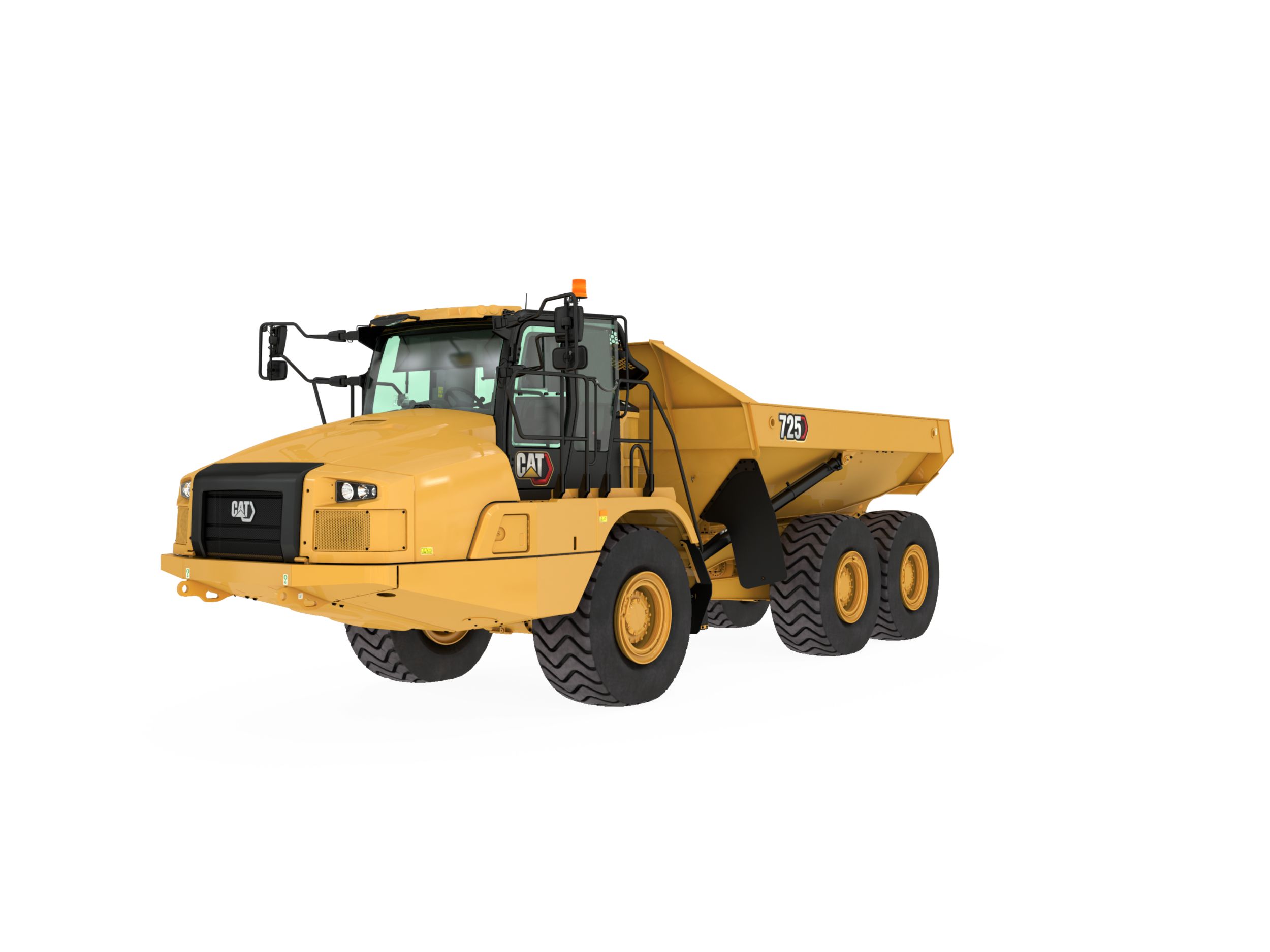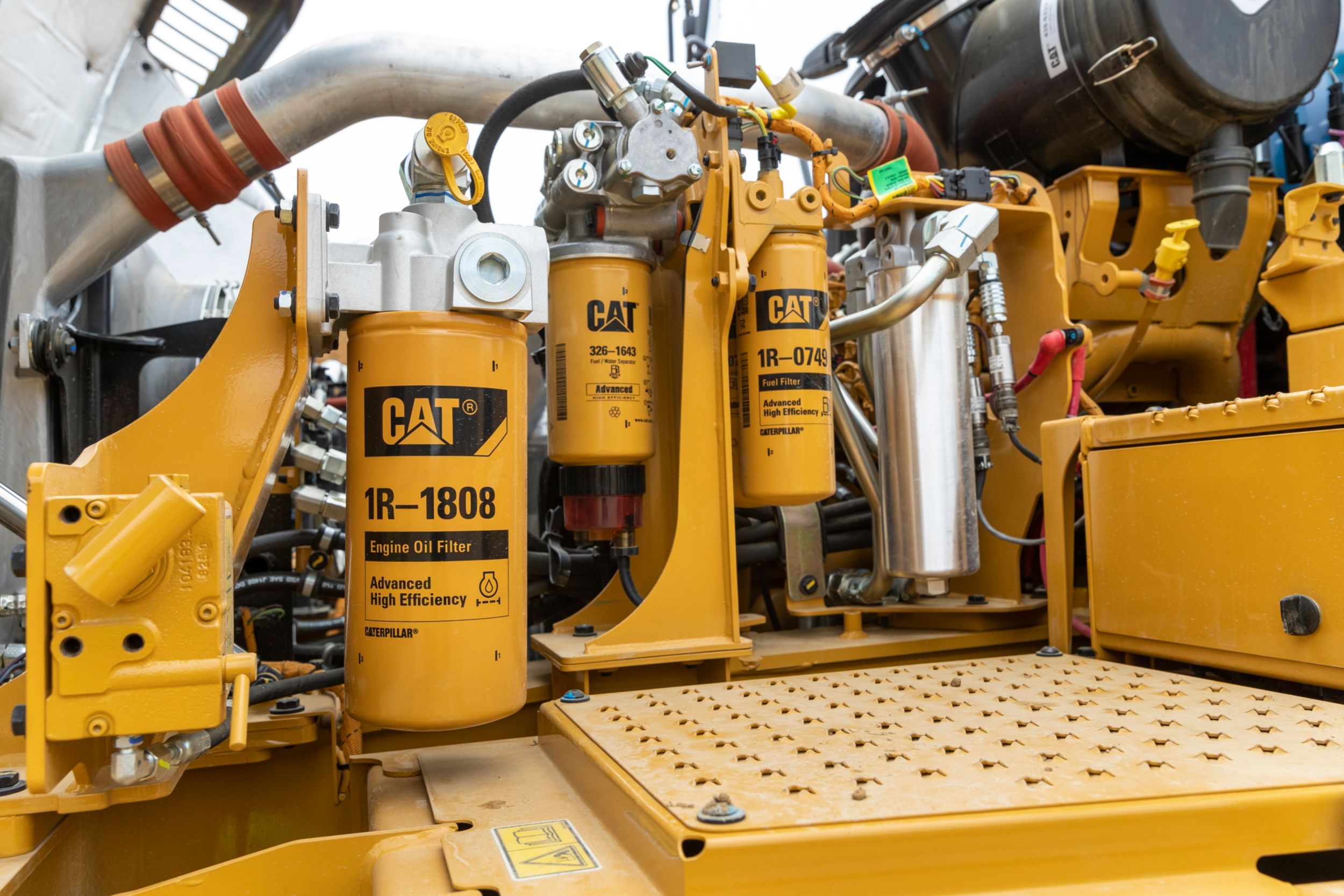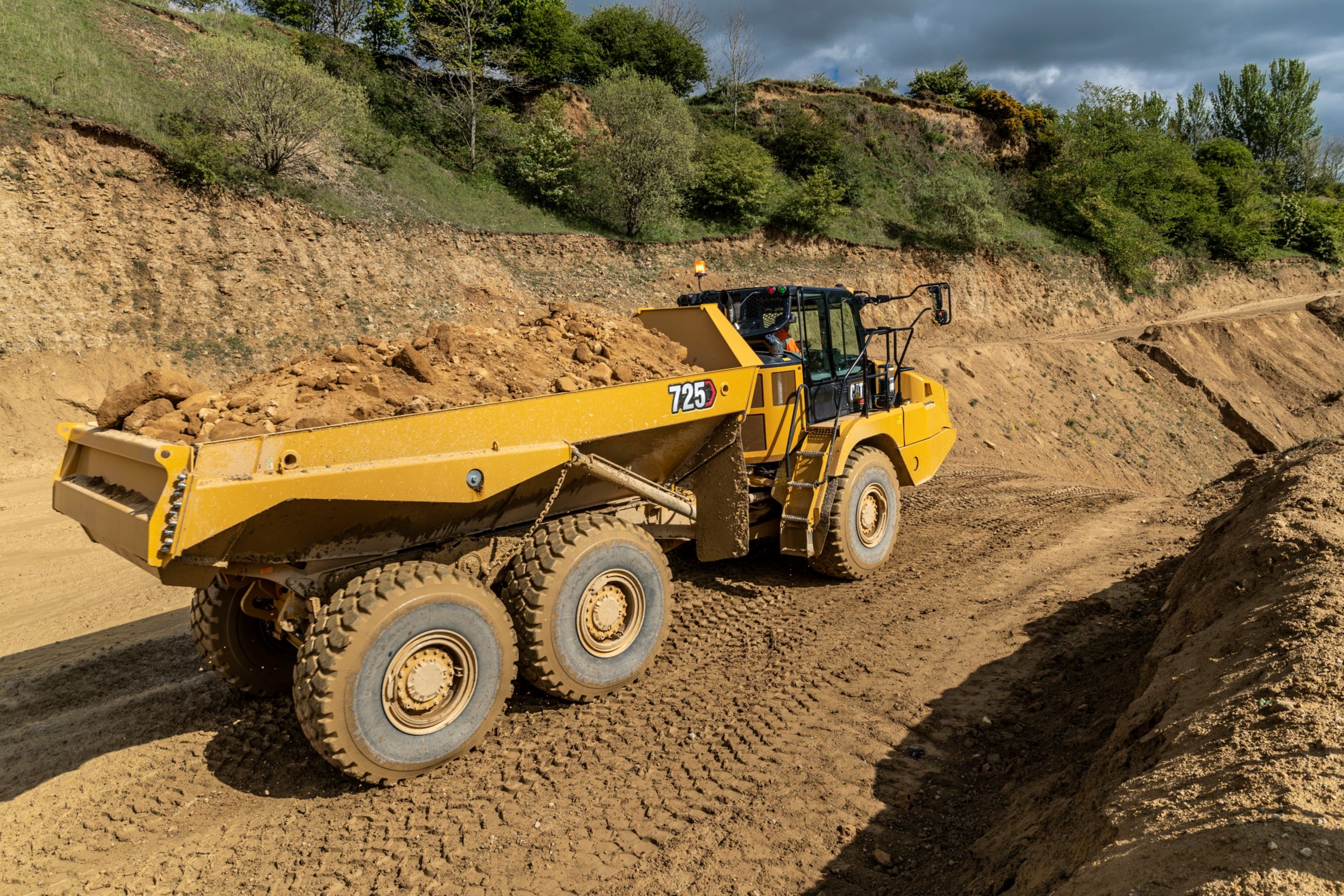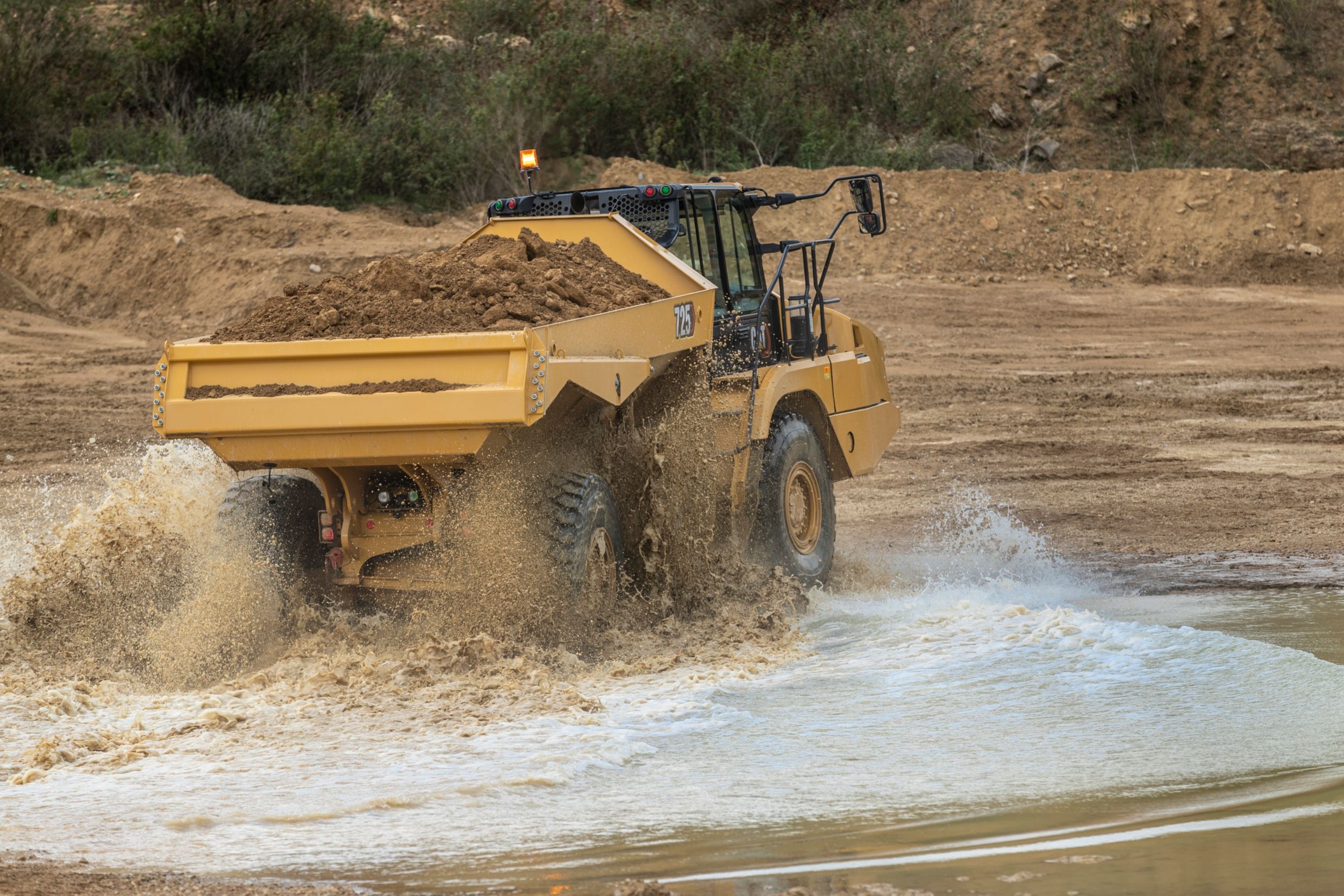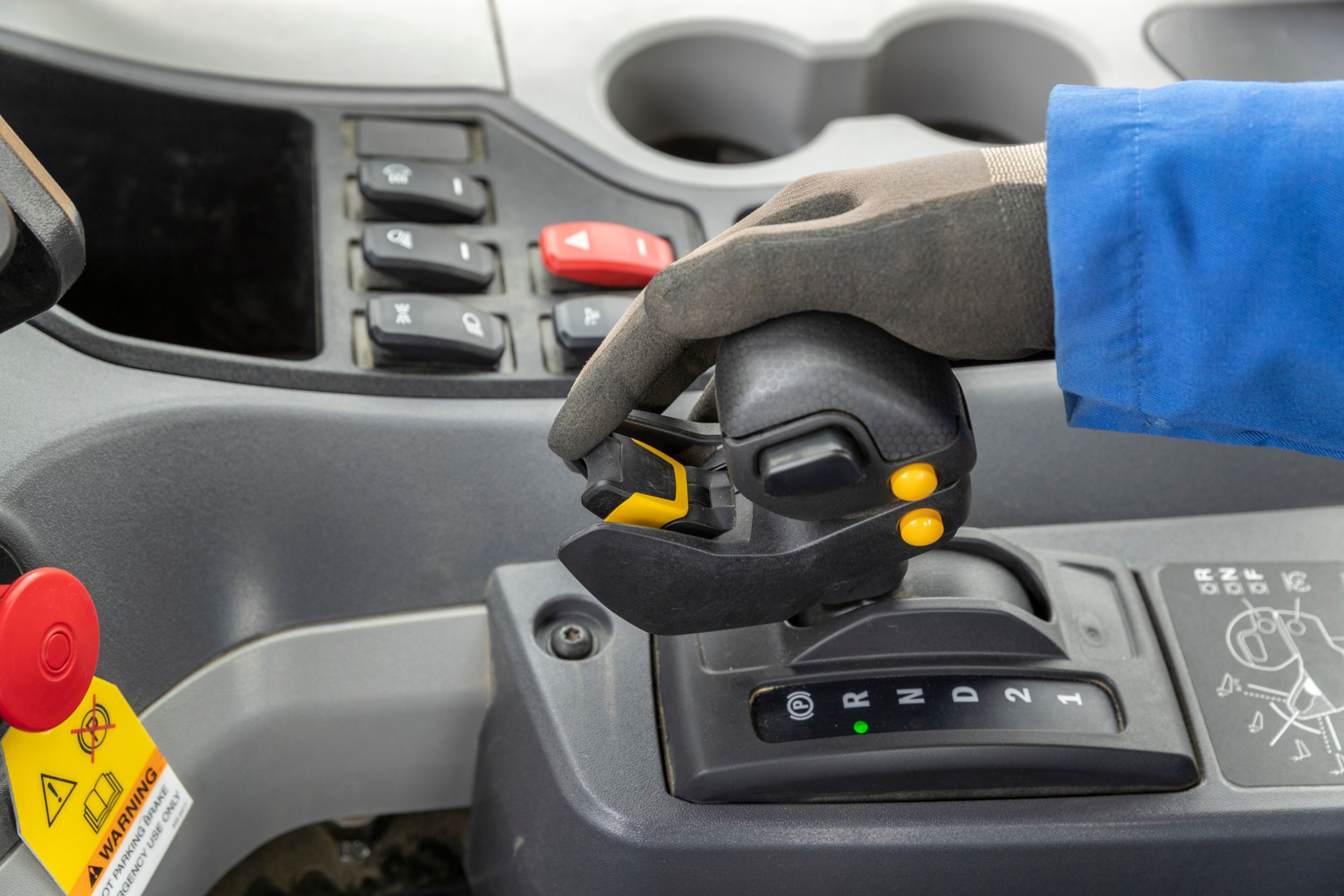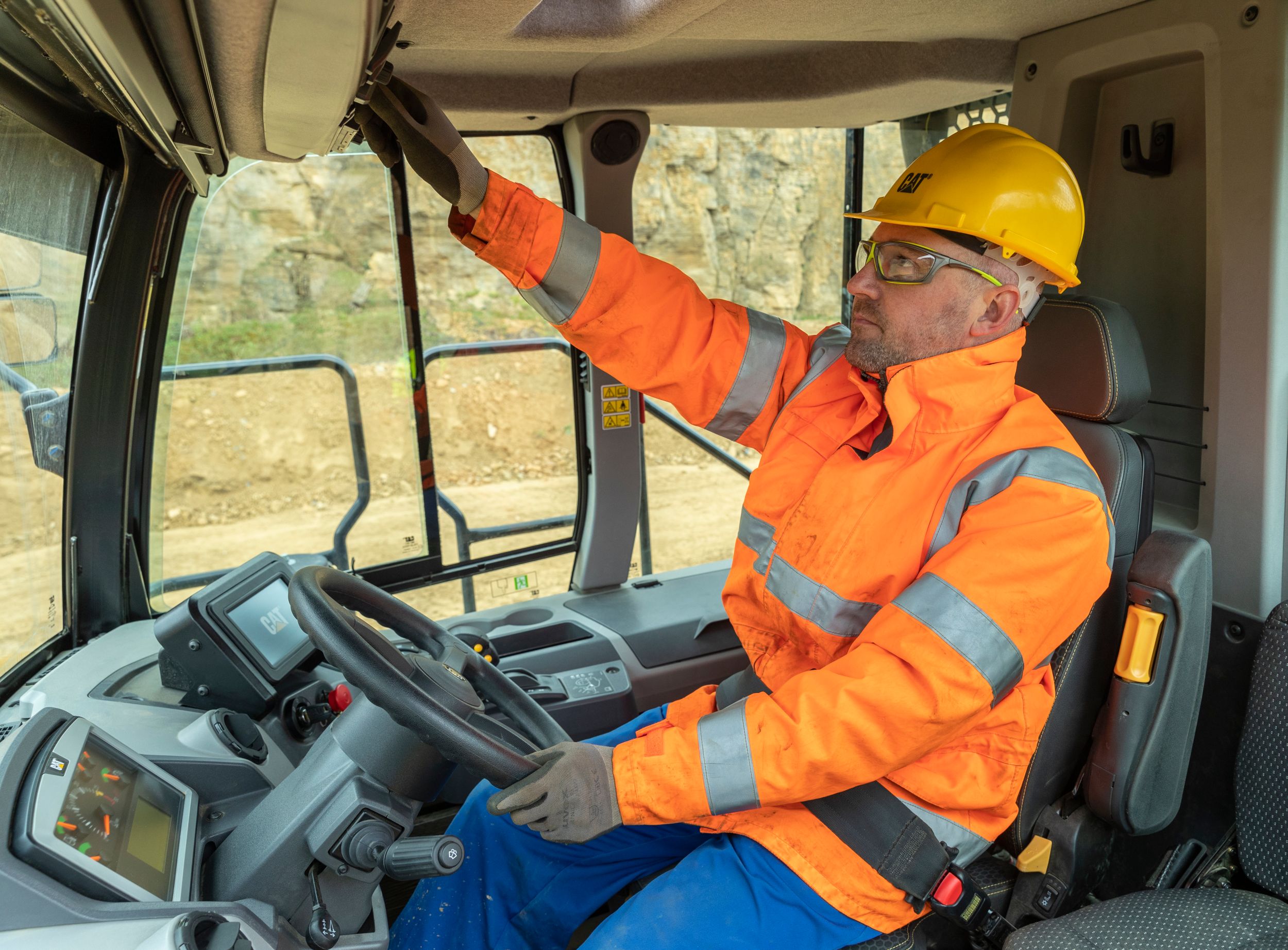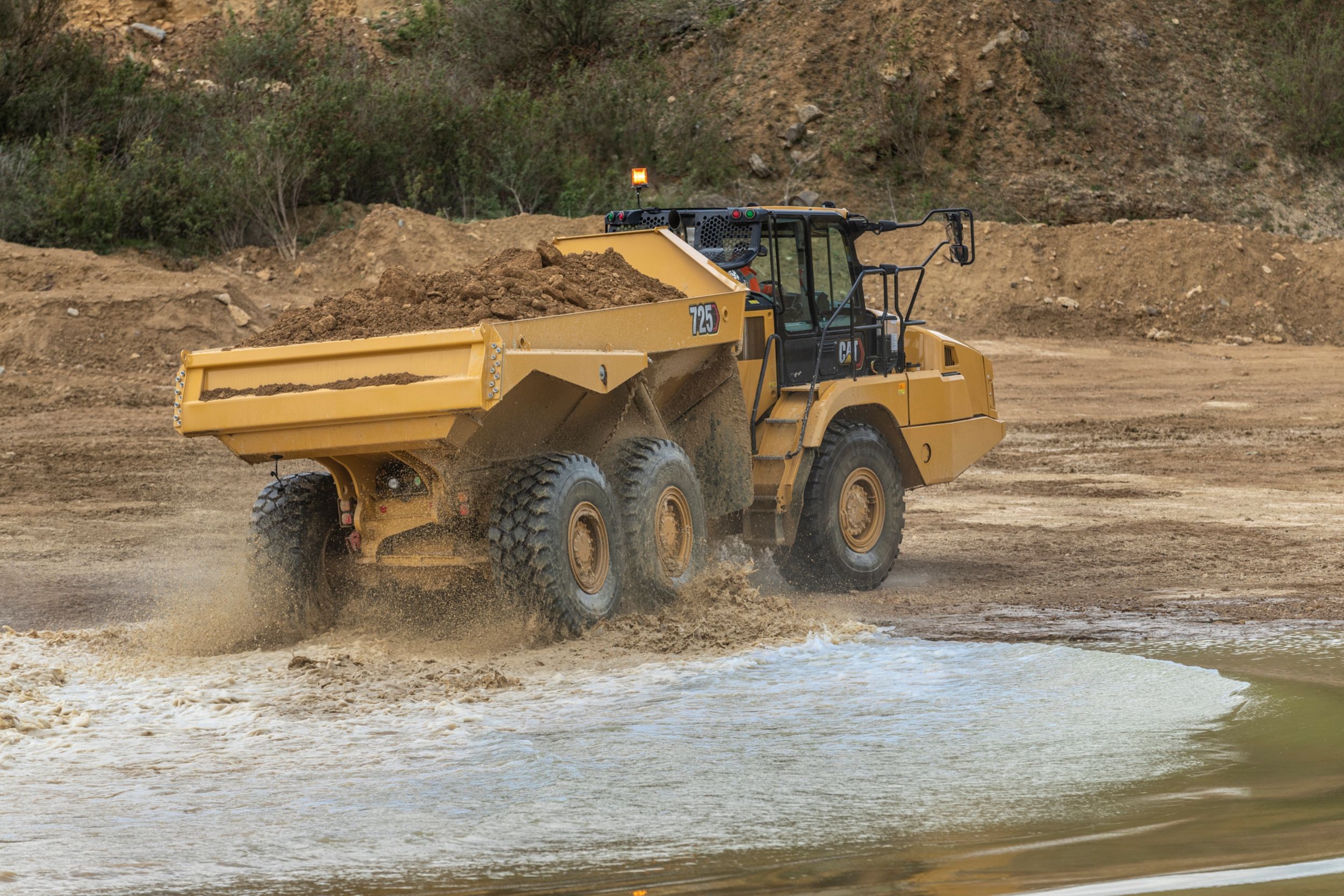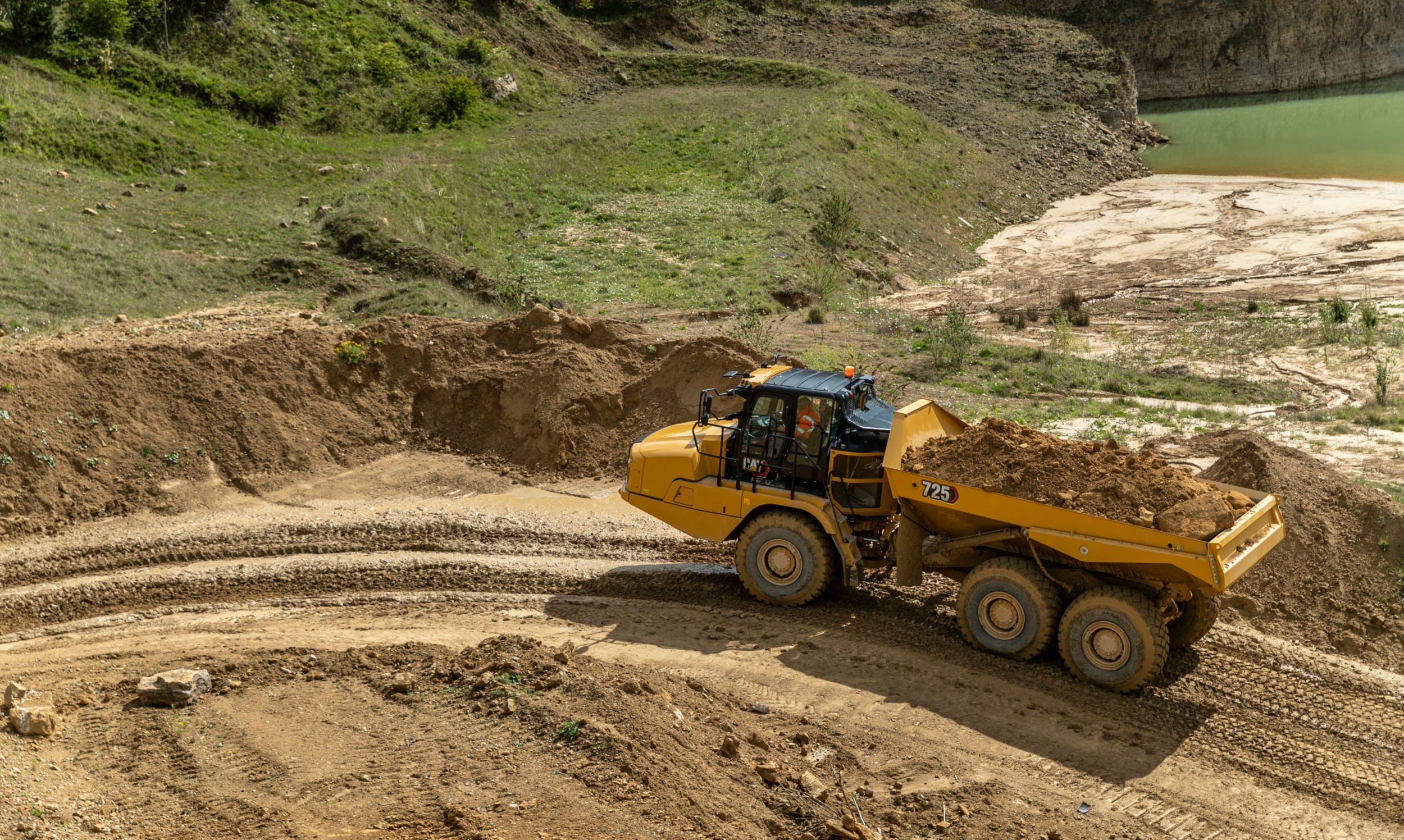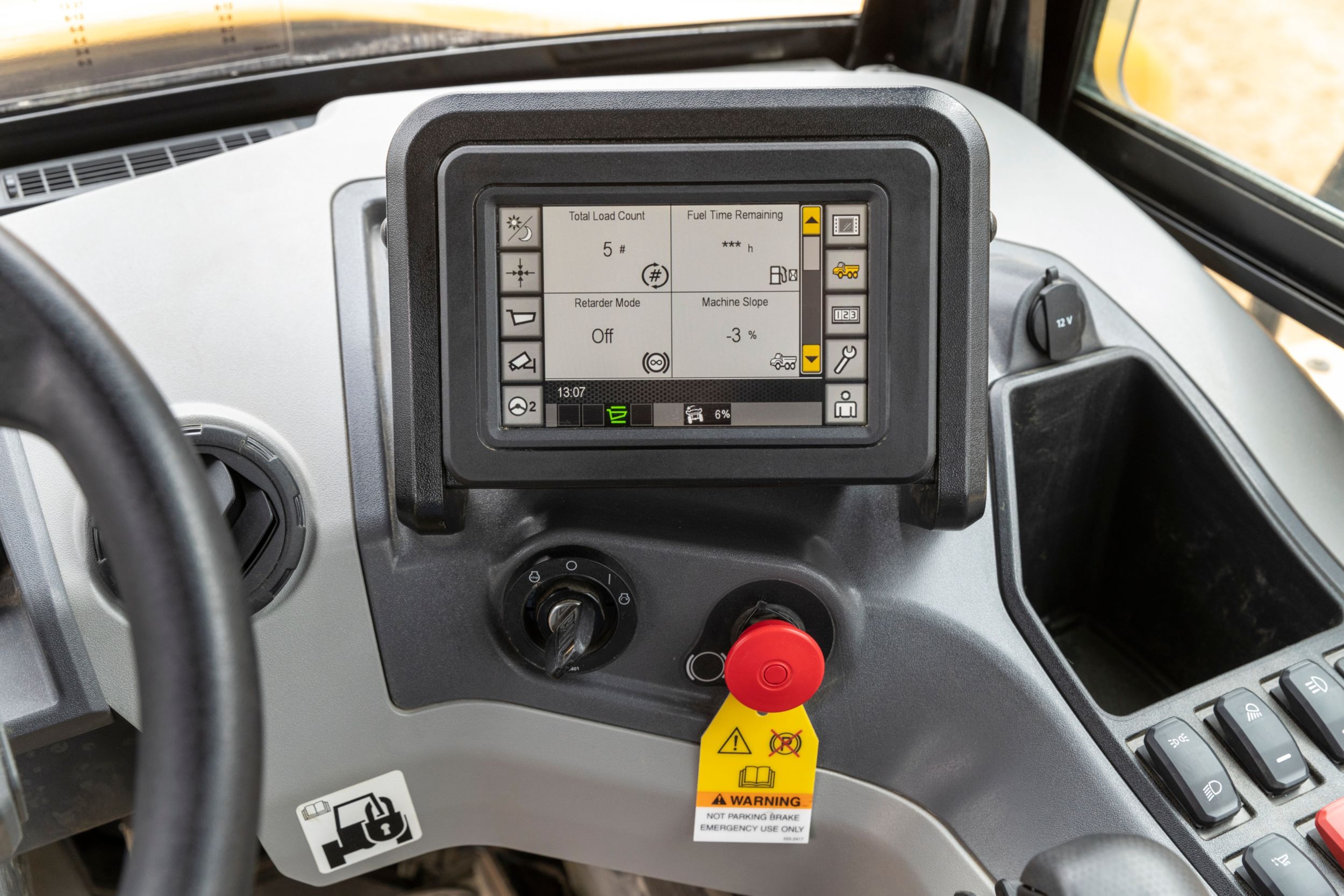725
725 - 2019, Tier 4 Final/EU Stage V, HRCOverview
The Cat® 725 features a world-class cab design, re-engineered using global operator feedback to advance comfort and ease of operation. Enhancements include new controls, transmission-protection features, hoist-assist system, advanced automatic traction control system, automatic retarder control, stability-assist machine rollover warning system, and a fuel saving ECO mode.
Specifications
Units:
| Engine Model | Cat® C9.3 |
| Rated Payload | — |
| Heaped (SAE 2:1) | — |
Benefits & Features
June 30, 2025
Specifications
Units:
| Engine Model | Cat® C9.3 |
| Gross Power (SAE J1995) | — |
| Net Power (SAE J1349) | — |
| Engine Power (ISO 14396) | — |
| Bore | — |
| Stroke | — |
| Displacement | — |
| Note (1) | Advertised power is tested at 1,700 rpm. |
| Note (2) | Advertised power is tested per the specified standard in effect at the time of manufacture. |
| Note (3) | The net power advertised is the power available at the flywheel when the engine is equipped with alternator, air cleaner, muffler, and fan at minimum speed. |
| Note (4) | Net power when the fan is at maximum speed is 249 kW (334 hp) per the SAE reference conditions. |
| Note (5) | Meets U.S. EPA Tier 4 Final/EU Stage V, Japan 2014, and Korea Stage V emission standards. |
| Note (6) | Diesel exhaust fluid (DEF) used in Cat SCR systems must meet the requirements outlined in ISO 22241-1. ISO 22241-1 requirements are met by many brands of DEF, including those that carry the AdBlue or API certifications. |
| No Engine De-rating Below | — |
| Peak Engine Torque Gross (SAE J1995) | — |
| Peak Engine Torque Net (SAE J1349) | — |
| Peak Engine Torque Speed | — |
| Rated Payload | — |
| Air Conditioning | If equipped with R134a (Global Warming Potential = 1430), the system contains 1.1 kg (2.4 lb) of refrigerant which has a CO 2 equivalent of 1.716 metric tonnes (1.891 tons). |
| Heaped (SAE 2:1) | — |
| Struck | — |
| Tailgate Heaped SAE 2:1 | — |
| Tailgate Struck | — |
| Forward - 1 | — |
| Forward - 2 | — |
| Forward - 3 | — |
| Forward - 4 | — |
| Forward - 5 | — |
| Forward - 6 | — |
| Reverse - 1 | — |
| Note (1) | The declared dynamic operator sound pressure level is 69±2 dB(A) when "ISO 6396:2008" is used to measure the value for an enclosed cab. The measurement was conducted at 70% of the maximum cooling fans speed. The sound level may vary at different cooling fan speeds. The measurement was conducted with the cab doors and the cab windows closed. The cab was properly installed and maintained. |
| Note (2) | Hearing protection may be needed when operating with an open operator station and cab (when not properly maintained or doors/windows open) for extended periods or in noisy environments. |
| Front Axle - Empty | — |
| Center Axle - Empty | — |
| Rear Axle - Empty | — |
| Total - Empty | — |
| Front Axle - Rated Load | — |
| Center Axle - Rated Load | — |
| Rear Axle - Rated Load | — |
| Total - Rated Load | — |
| Front Axle - Loaded | — |
| Center Axle - Loaded | — |
| Rear Axle - Loaded | — |
| Total - Loaded | — |
| Type | High strength Brinell HB450 wear resistant steel |
| Front Plate | — |
| Base Plate | — |
| Side Plates | — |
| Scow | — |
| Fuel Tank | — |
| Cooling System | — |
| Steering/Hoist Hydraulic System | — |
| Engine Crankcase | — |
| Transmission | — |
| Output Transfer Gear Box | — |
| Final Drive - Each | — |
| DEF Tank | — |
| Raise Time | — |
| Lower Time | — |
| Brakes | ISO 3450 – 2011 |
| Cab - FOPS | ISO 3449 - 2005 Level II |
| Cab - ROPS | ISO 3471 – 2008 |
| Steering | ISO 5010 – 2019 |
| Turning Dimensions - Steer Angle - Left/Right | 45° |
| Turning Dimensions - SAE Turning Radius | — |
| Turning Dimensions - Clearance Radius | — |
| Turning Dimensions - Inside Radius | — |
| Turning Dimensions - Aisle Width | — |
| Note | Dimensions are for machines equipped with 23.5R25 tires. |
| Lock to Lock | 4.75 seconds @ 60 rpm |
| Hydraulic Excavators: 349/352 - Passes | 4-5 |
| Hydraulic Excavators: 336 - Passes | 5-6 |
| Wheel Loaders: 972/972 XE - Passes | 3-4 |
| Wheel Loaders: 966/966 XE - Passes | 4 |
| Wheel Loader: 962 - Passes | 4-5 |
| Wheel Loader: 950 - Passes | 5 |
| Note | An optimum system match gives you a major productivity advantage. The 725 is an excellent match for the Cat 349/352 and 336 Hydraulic Excavators and Cat 972, 966, 962, and 950 Wheel Loaders. Having matched loading and hauling tools results in increased production and lower system costs per unit of volume moved. |
Benefits & Features
MAXIMIZE PERFORMANCE
- Every Tier 4 Final/EU Stage V Cat engine is equipped with a combination of proven electronic, fuel, air and aftertreatment components.
- Maximized uptime and reduced cost with world-class support from the Cat dealer network.
- Minimized impact of emission systems: designed to be transparent to the operator without requiring interaction.
- Delivering better fuel economy with minimized maintenance costs while providing the same great power and response.
- Advanced MEUI-C injector platforms deliver increased injection pressures and more precise fuel rates. These durable injectors enhance responsiveness while controlling soot.
- All Cat engines feature innovative air-management systems that optimize airflow and enhance power, efficiency and reliability.
- The Cat NOx Reduction System (NRS) captures and cools a small quantity of exhaust gas, then routes it back into the combustion chamber where it drives down combustion temperatures and reduces NOx emissions.
- Cat engines equipped with a Selective Catalytic Reduction (SCR) system inject Diesel Exhaust Fluid (DEF) into the exhaust to reduce NOx emissions. DEF is a precisely mixed solution of 32.5 percent high purity chemical grade urea and 67.5 percent de-ionized water.
INDUSTRIAL GRADE TRANSMISSION
- The Cat CX31 six-speed forward, single-speed reverse transmission features Advanced Productivity Electronic Control Strategy (APECS) and Electronic Clutch Pressure Control (ECPC) which deliver smooth gear changes with improved acceleration and higher productivity.
- Speed hold/limiting function allows the machine speed to be limited in 1 km/h or 1 mph steps to conform to site speed restrictions.
- Gearshifts have been significantly improved to maintain direct drive lock-up, and eliminate dropping into converter drive. Reducing the use of torque converter drive helps maintain ground speed and gradeability.
- Variable shift points used based on the operating conditions, which also aid in maintaining ground speed during gear changes on grades.
- Critical gearshifts maintain direct drive lock-up, and eliminate dropping into converter drive. This maintains ground speed during shifts on grades.
- The transmission automatically modifies shift points to best suit operating conditions and performance.
- Retarding levels are automatically reduced on lesser grades in lower gears.
- Large capacity torque converter, configured for off-highway applications, allows the higher engine power to be transmitted more efficiently to the lower power train.
- The engine compression brake improves retarding response and increases retarding power.
AUTOMATIC CONTROLS
- Advanced automatic traction control (AATC) is a proactive application of the inter- and cross-axle differential locks is ‘on-the-go’ and fully automatic. The operator does not have to think about when and where to engage either diff lock. Sensors monitor the machine and wheel speeds, enabling instant response in high rolling resistance conditions. Operation is seamless and smooth, eliminating wheel slip for maximum traction and therefore productivity.
- AATC reduces tire and driveline abuse, eliminating lost machine efficiencies caused by improper manual operation of the differential clutches and reducing the cost of premature tire replacement.
- Automatic retarder control (ARC) makes use of the retarder easier for the operator to use. As with AATC, a number of machine operating aspects are monitored. If required, the engine compression brake is engaged automatically to control machine speed when descending a grade. The system can help towards eliminating engine overspeed, improving safe machine operation and reducing cycle times, yet still having the flexibility of manual control if needed.
- With the assisted dumping system, tipping of the dump body can be done automatically with the new Assisted Hoisting Control. Flick the new body raise/lower switch and the machine will apply the service brakes, switch the transmission to neutral and raise the body at the required engine rpm. Lowering the dump body is done the same way, flick the switch and the machine will lower the body and place it in float. Two flicks, one up, one down.
- Hill Assist reduces potential ‘roll-back’ on grades. If an operator stops the machine on a grade, when taking his foot off the service brake pedal, the machine will automatically hold the service brakes to prevent machine rolling backwards.
- Waiting brake applies the service brakes when neutral gear is selected, allowing quick and easy control of the machine at the load or dump area.
POWERFUL EFFICIENCY
- The new cab is designed to make all aspects of machine operation as simple as possible for every operator. The controls and gauges are easy to read and straightforward to use, allowing the operator to focus on safe machine operation while maintaining productivity.
- Unique to Cat articulated trucks, the combined hoist/transmission lever provides easy, intuitive control of gears and hoist functions. The new assisted hoist system gives improved control to the operator, allowing for faster cycle times and less control movements.
- Offering both automatic and manual options, the system gives operators flexibility to choose their preferred method of control. When using the automatic system to tip a load, the machine neutralizes the transmission, applies the service brakes and hoists the body to maximum angle at the required engine rpm. When lowering the body this feature prevents a hard stop onto the frame, eliminating shock loads and potential damage. Automatic use can reduce operator interactions by up to 50 percent, compared to the previous model, depending on the site tipping procedure.
- Also incorporated into the lever are waiting brake, transmission hold, machine speed limiter and parking brake selection. This gives operating a more automotive feel. No separate switch is now needed; you just push the lever into park.
- The newly styled and updated dash puts all controls within easy reach of the operator. It features LED illuminated rocker switches for easy use in all operating conditions. The fit and finish delivers an automotive feel with the industrial strength you would expect from Caterpillar.
- The updated touchscreen dash mounted display allows the operator to monitor and adjust various levels of machine performance and conditions, as well as machine warning categories. These include configuration settings, operator and machine totals, service information, various machine status parameters, machine payload information (when fitted), stability assist, and the video feed from the rearview camera.
- Make and receive hands free calls via the optional Bluetooth equipped stereo with clearer quality due to the quieter cab and upgraded speakers.
WORK IN COMFORT
- The large open cab offers a comfortable working space for both the operator and an additional person (e.g. training purposes). The second seat is fully padded with a backrest and a wide, retractable seat belt for a secure and comfortable ride. Positioned adjacent to the operator, the seat gives the trainer a clear view of the instrument panel, controls and the road ahead.
- A new large side storage box is heated or cooled by the HVAC system depending on operator preference. Twin cup holders and multiple storage spaces have also been introduced to help give operators an uncluttered workspace.
- The new air suspension seat gives an increased range of adjustments over previous offerings including fore/aft isolation, which dramatically reduces horizontal vibrations and jolts. This provides a greater number of operators with the ability to tailor their seating position for a more comfortable working day.
- The improved automatic climate control system gives you the option to maintain the temperature desired by the operator. A reduction to in-cab noise 69±2 dB (–7 dB from previous model) contributes to a more comfortable working environment for the operator, all day, every day.
BUILT TO PERFORM
- All three axles have oscillating A-frames with lateral tie rods, controlling sideways movement of the axle and providing stability. In conjunction with suspension system, it allows the operator to travel at speed over rough terrain and softens impact loads on structures and components.
- The front suspension has large bore, low-pressure cylinders are purpose designed for off-road applications and offer a soft, smooth ride for the operator. The front suspension oscillates ±6° to assist in providing a smooth ride. Suspension mounting points are integrated into the axle housing, increasing reliability.
- The rear suspension is comprised of a walking beam and Caterpillar designed long life rear suspension mounts; the rear suspension system provides a reliable and stable ride for excellent travel over rough terrain and aids load retention.
- Introduced for the first time on this model, the oil-immersed wet brake system is a multi-disc, multi-plate design.Enclosing the brakes prevents the ingress of contaminants. This protects the system, extends life, and reduces replacement costs while improving machine uptime.
HEAVY DUTY CONSTRUCTION
- The front frame design features a large box section and wide, stiff frame beams to handle torque loads. The divergent frame design decreases stress in the hitch area and optimizes suspension geometry. The frame design makes maximum use of robotic welding for increased durability.
- The rear frame twin-box construction minimizes stress concentrations and provides low weight with long service life.
- The three-point oscillating axle front suspension provides excellent ride quality. It also protects the truck from adverse road conditions by absorbing shock loads that would reach the frame.
- The articulating hitch provides the truck with steering articulation, and the oscillation helps provide all-wheel ground contact in rough terrain.
- All machines have a large target area dump body design to provide consistently high load carrying capacity. The diverging flow design gives clean material discharge, which maximizes production and avoids the waste of carry-back.
- The output transfer gear (OTG) distributes drive to the tractor and trailer and includes a wet clutch differential lock for optimum traction in poor underfoot conditions.
- Dual-circuit, all wheel braking system. The full power hydraulic system actuates enclosed, oil immersed, multi-disc, multi-plate brakes with independent front and rear circuits and accumulators.
TECHNOLOGY THAT GETS WORK DONE
- Cat Product Link wirelessly connect you to your equipment, giving you valuable insight into how your machine or fleet is performing. The system tracks location, hours, fuel usage, productivity, idle time, and diagnostic codes through the online VisionLink user interface so you can make timely, fact-based decisions to maximize efficiency, improve productivity, and lower costs.
- Cat Production Measurement brings payload weighing to the cab to help optimize job site efficiency and productivity. Operators can view real-time load weights on the integrated display and know precisely when target is achieved, while cab-mounted external payload lights on all four corners signal the loader operator when to stop, reducing the risk of machine overloading. Operators can track daily productivity from the cab, with quick access to truck payload weights, loads and cycle counts, and daily totals; or remotely via LINK technologies.
- Cat Detect with Stability Assist warns the operator if machine is approaching a pre-set angle during operation; when driving and tipping. If using the assisted hoist, the machine will stop hoisting the body and give an audible and visual warning. The system monitors angles of tractor, trailer and grade independently. This increases operator awareness of machine stability during operation. All tractor and/or trailer rollover events are logged and reported via VisionLink.
Data not available.
Standard Equipment
- NOTE
- Standard and optional equipment may vary. Consult your Cat dealer for details.
- OPERATOR ENVIRONMENT
- Air conditioning
- Machine operation monitoring system includes:<br>– Action lamp<br>– Engine oil pressure<br>– Primary steering system<br>– Left and right turn signal<br>– High beam<br>– Coolant temperature<br>– Tachometer<br>– Parking brake<br>– Fuel level<br>– Transmission oil temperature<br>– Brake system<br>– Transmission hold<br>– Hoist control<br>– Hydraulic system<br>– Charging system<br>– Retarder<br>– Transmission fault<br>– Traction control system<br>– Check engine lamp
- Windows opening both sides, tinted
- Storage:<br>– Cup holder<br>– Flask receptacle<br>– Under seat storage<br>– Door pocket<br>– Behind operator seat storage<br>– Coat hook
- Glass windows:<br>– Front, laminated and tinted<br>– Sides and rear, toughened and tinted
- Seats:<br>– Operator: fully adjustable, air suspension<br>– Trainer: padded with lap belt
- Tilt and telescopic steering wheel
- Retractable belt: Operator seat and second seat
- Adjustable air vents
- Heater and defroster with four-speed fan
- Sun visor
- Touchscreen display incorporating the rearview camera video feed
- Windshield wiper and washer, two speed, intermittent (front)
- Combined gear selection and hoist control lever
- Liquid Crystal Display (LCD):<br>– Alert indicator<br>– Selected gear and direction<br>– Speed or auto shift<br>– Review Operation and Maintenance Manual (OMM)<br>– Primary steering failure warning<br>– Seat belt warning<br>– Secondary steering failure warning<br>– Diesel Particulate Filter (DPF) regeneration filter<br>– Secondary steering energy source engaged<br>– Hour meter<br>– Retarder active
- Secondary steering – electro hydraulic
- Mirrors: exterior
- TECHNOLOGY
- Product Link Cellular PLE643
- Cat® Detect with Stability Assist
- ELECTRICAL AND LIGHTING
- Electrical system: 24-volt, 5A 24- to 12-volt converter
- Lighting systems:<br>– Cab interior<br>– Two head lamps<br>– Two width marker<br>– Two reversing<br>– Work light/cab access light<br>– Two stop/tail lights<br>– Front and rear direction indicators
- Main disconnect switch
- Horn
- Batteries (two) maintenance free
- Remote starting receptacle (cables not included)
- POWERTRAIN
- Differentials: standard with automatic clutched inter- and cross-axle differential locks
- Cat Clean Emission Module (CEM) and exhaust aftertreatment package
- Cat C9.3 engine
- Three axle, six-wheel drive
- Hydraulic retarder
- Dual circuit oil immersed, enclosed brakes – all wheels
- Auto shift six-speed forward and single speed reverse transmission
- SAFETY
- Reverse alarm
- Rearview camera
- Rollover protective structure/falling objects protective structure (ROPS/FOPS) cab
- GUARDS
- Front dump body spill guard, integral part of fabricated body
- Crankcase
- Rear window
- Radiator
- OTHER STANDARD EQUIPMENT
- Vandalism protection: lockable caps
- Mud flaps: wheel arch and body mounted with transportation tiebacks
- Sound suppression (standard in some countries*)<br>–*EFTA countries are EU countries plus Iceland, Norway, Lichtenstein, Switzertland, Türkiye and UK.
- S·O·S sampling valves
- Tires, six 23.5R25
Optional Equipment
- NOTE
- Standard and optional equipment may vary. Consult your Cat dealer for details.
- OPERATOR ENVIRONMENT
- Infrared glass – high ambient cab
- Mirrors, heated motorized
- Radio, Bluetooth® stereo system
- Heated/cooled seat
- Four-point seat belt
- Window blinds
- Windshield wiper and washer, single-speed (rear)
- TECHNOLOGY
- Machine Security System (MSS)
- Cat® Payload
- Product Link Dual PLE683
- ELECTRICAL AND LIGHTING
- Cold weather start attachment
- Engine block heater
- Ether start
- Flashing LED beacon
- Roof mounted LED work lights
- OPTIONAL EQUIPMENT
- Cold weather coolant –51° C (–60° F)
- Auto lube installation for automatic greasing of bearings
- Bare chassis (no body) standard wheel base
- Exhaust heated body
- Fuel additive – anti-waxing
- Body liners
- Fast fuel fill
- Wheel chocks
- Scissor tailgate
